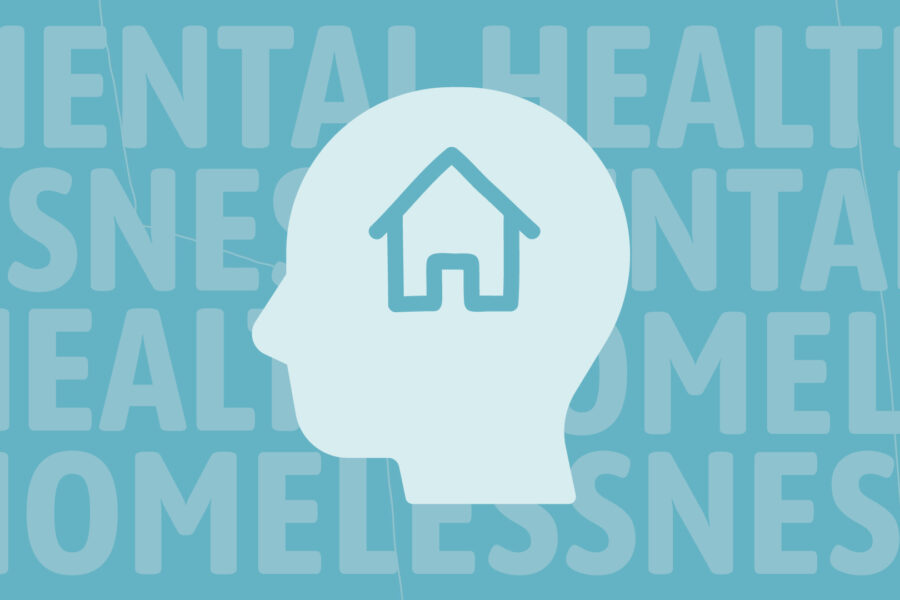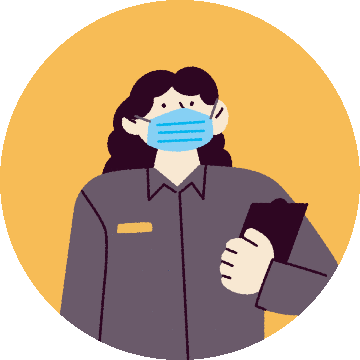There are many questions and misunderstandings about the relationship between mental health and homelessness. In order to strengthen our own understanding, Community Solutions explored the existing research and evidence on this topic, which you can read here. Additionally, we asked several experts in these fields to provide their insights on commonly asked questions about mental health and homelessness. Read on to see what they shared.
HOUSING AND MENTAL HEALTH PERCEPTIONS
What is the relationship between mental illnesses and homelessness? Is there a strong correlation between the two? What proportion of people experiencing homelessness are living with mental illnesses?
The relationship is subject to misunderstanding. Since deinstitutionalization began in the 1960s, persons with serious mental illness left mental hospitals to find too few clinics and outpatient supports in the community. Consequently, many are under-treated, unhoused, and unable to pursue recovery and stability in their lives. Persons experiencing homelessness and serious mental illness comprise a minority (around 30%) of the larger homeless population, yet they are more prominent in media reports and negative public perceptions due to stigma.
Source: Dr. Deborah K. Padgett, PhD, MPH, MA, BA, Professor, Silver School of Social Work, New York University
Is it possible for an unhoused neighbor living with a serious mental illness to maintain housing? What helps them successfully maintain housing?
Yes! If housed right away and offered support services 24/7 (the Housing First approach). Studies of Housing First programs in the U.S., Canada, and Western Europe consistently show that 80-90% of tenants (all of whom have a serious mental illness) remain stably housed after one to three years compared to their peers who are not in Housing First programs. The key to success is to ensure it is not “housing only” and that adequate support services are offered as critical to stability and recovery.
Source: Dr. Deborah K. Padgett, PhD, MPH, MA, BA, Professor, Silver School of Social Work, New York University
How common is it for unhoused neighbors living with mental illnesses to be “service resistant”? What is actually behind this belief of the majority of people experiencing homelessness being “service resistant”?
For some, this is a rational decision. These individuals know (or have experienced directly) how unsafe, crowded, and dehumanizing homeless shelters are. Available only for night-sleeping (residents required to leave during day hours), the noise, and close quarters of shelter beds — along with the constant vigilance to protect one’s self and belongings — is a “service offer” that invites resistance.
Source: Dr. Deborah K. Padgett, PhD, MPH, MA, BA, Professor, Silver School of Social Work, New York University
How can systems and processes be more intentionally designed with/for unhoused neighbors living with mental illnesses?
First, the cornerstone of any system of care must first include a focus on prevention of homelessness — an area often given scant attention — among people with mental illness. It is not mental illness itself, but lack of systems of care for people with mental illness that leads to homelessness. Upstream factors, such as adverse childhood experiences, insufficient access to mental health services, racial inequities, rising income inequality, and the growing unaffordability of housing all are reasons that people with mental illness ultimately become homeless. Only by focusing policy efforts to mitigate these upstream determinants and their effects will homelessness in people with mental illness be truly reduced.
For those who become homeless, the health care system must offer flexible, proactive community-based models of mental health care. Street outreach teams, which seek to build relationships and trust with unhoused people over time to encourage them to connect care, as well as clinics embedded in shelters, which facilitate accessing care for people who may not receive it otherwise, are therefore critical. Models like Boston Health Care for the Homeless Program (BHCHP) and other related programs nationwide seek to create this as a mainstay of treatment. Traditional academic medical centers would benefit from having more flexible clinics that allow for walk-in appointments for this population, as well as systems for screening for unhoused patients, optimizing clinical care and medication prescribing for unhoused patients, and facilitating discharge planning to minimize people returning to the street.
For those on the pathway to housing, it is critically important to guide and support the person with mental illness so that they can thrive in housing. Housing First, which provides immediate access to subsidized, independent housing without pre-condition, is an important and effective model but will only work if the support offered is tailored to each individual. The type of housing the patient would benefit from, the location where the person is housed, and what services the person receives all need to be carefully considered. People with mental illness have unique challenges and goals in housing that should be addressed proactively through individualized housing plans, just like there are individualized psychiatric treatment plans.
Source: Katherine Koh, MD, MSc, Street Psychiatrist, Boston Health Care for the Homeless Program and Massachusetts General Hospital
COMMUNITY CHALLENGES AND SUCCESSES
What kinds of challenges do communities face when supporting neighbors living with mental illnesses? How have they worked to address them?
The “Not In My Backyard” (NIMBY) phenomenon is known to affect communities and their willingness to address behavioral health and social problems. When symptoms of mental illness are visible, there are community challenges with overcoming stigma, involving family members and loved ones of individuals with mental illness, supporting treatment adherence issues, and finding availability of peer supports in the community. Many symptoms of mental illness are invisible, which introduces another set of challenges, such as identifying community mental health needs, helping individuals seek the mental health care they need, and supporting primary and secondary prevention of mental illness in the community.
There are many resources to help communities. One example is the National Alliance on Mental Illness (NAMI) which operates local branches throughout the U.S. Another example is the Early Psychosis Intervention Network, which began as a research project and has now expanded to a national network of regional hubs to provide specialty services for individuals experiencing psychosis for the first time with the hopes of intervening early to prevent future psychosis. Technology has also expanded opportunities to create virtual communities and there are many online resources available.
Source: Anthony Love, Principal Advisor, Intra/Inter-Agency Collaboration and Director of Community Engagement, Homeless Programs Office, Veterans Health Administration, U.S. Department of Veterans Affairs
What do local Built for Zero leaders wish others knew about unhoused neighbors living with mental illnesses?
These individuals can be successfully housed through Housing First, especially when paired with supportive housing. In our locality, we used Continuum of Care vouchers that made rent affordable but also provided case management. We also know that it takes time to develop trust, so it was very helpful to have a low-barrier shelter where individuals could stay even if they were not ready for medication or treatment.
Source: Julia Orlando, CRC, Ed.M, MA, Director, Bergen County Housing, Health and Human Services Center
SYSTEM IMPROVEMENTS
What can be (or has been) done to help unhoused neighbors living with mental illnesses navigate these systems to get the services they need?
Unhoused people with mental illness have often experienced tremendous adversity, trauma, and challenging life experiences, making it difficult to trust others. Homelessness also makes it difficult for them to be able to plan beyond meeting basic needs. Mental illness itself can also rob people of their ability to reason and know they need help. For all these reasons, patients with homelessness and mental illness are understandably often reluctant to seek care and resources.
Proactive models of outreach, as offered by Boston Health Care for the Homeless Program as mentioned above, are therefore key ways to help engage and build trust over time with people who may not receive care otherwise. Other evidence-based models include assertive community treatment teams, which provide treatment, rehabilitation, and support services specifically for people with severe and persistent mental illness through multidisciplinary professionals. Evidence suggests that unhoused people are more likely to engage in mental health care when paired with housing and medical services, so interdisciplinary teams are an important way to create connections with mental health services. Having a case manager to help navigate the tremendously complex worlds of social services, health care, and housing is also valuable to connect people to IDs, shelter, food, clothing, appointments, housing, and other resources.
It is also important to keep in mind that unhoused individuals themselves are often very capable and creative individuals who have already found a way to navigate the incredible challenges and complexities that come with the experience of homelessness. Having a caring individual to help them tap into and remind of these strengths can also help empower them to navigate many of these resources themselves. With the right support, these individuals are capable of accessing and engaging with the resources that will lead them to the life they desire and deserve.
Source: Katherine Koh, MD, MSc, Street Psychiatrist, Boston Health Care for the Homeless Program and Massachusetts General Hospital
PARTNERSHIPS AND ADJACENT SYSTEMS
What are best and worst practices when encountering a neighbor living with a mental illness? What are the policies and procedures that communities doing it right use?
Assuming that the unhoused neighbor is behaving erratically or in some threatening manner, the best practice for first responder teams is to adopt a de-escalation posture. Ideally, the team is comprised of mental health professionals who prioritize patience over confrontation. The worst practice is, unfortunately, the most commonly used, i.e., an emergency team led by police officers who are trained to confront and restrain and have little knowledge or understanding of mental illness.
Source: Dr. Deborah K. Padgett, PhD, MPH, MA, BA, Professor, Silver School of Social Work, New York University
What kinds of partnerships have enabled communities to support unhoused neighbors living with mental illnesses? What has that looked like?
These types of partnerships include Federally Qualified Health Centers (FQHCs) and County Mental Health Agencies. There have been partnerships with Housing Authorities and FQHCs in Oregon that connected identified high-cost health users that were in permanent supportive housing (PSH) to FQHCs.
Prior to moving into housing, the FQHC helped conduct a vulnerability assessment for housing and would make the referral to the PSH. The individual(s) stayed connected to the FQHC after moving in. Also, in a number of cities, there are Healthcare for the Homeless organizations that are part of the Continuum of Care. They provide care while the individual is unsheltered, in a shelter or in Transitional Housing.
Source: Anthony Love, Principal Advisor, Intra/Inter-Agency Collaboration and Director of Community Engagement, VHA Homeless Programs, Department of Veterans Affairs Central Office
Why is policing not always a helpful response when working with unhoused neighbors experiencing mental health crises?
Traditional policing may not be the best response because many times in the past, people’s experiences with traditional law enforcement may have been traumatic, and individuals in crisis don’t see law enforcement as there to help. As a result of prior experiences, individuals can escalate super quickly and that can lead to further trauma, validate belief systems that law enforcement equates to incarceration and increase the likelihood of increasing a sense of mistrust (kind of like a self-fulling prophecy).
In total, law enforcement usually only gets 40 hours of training on mental health. As a result, there is an inherent lack of full understanding of (a) how to identify a mental health crisis and (b) not having the ability to utilize de-escalation techniques needed for each identified diagnosis. Clinicians see situations in a clinical lens, not law enforcement.
Source: Heidi M. Grove, MA, HSBC Systems Manager, Boulder County Community Services, and Jennine Hall, PhD, LAC, Program Manager for the Boulder County Co-Responder Team
What alternatives are there to calling the police to help with unhoused neighbors experiencing mental health crises?
The currently identified alternatives are as follows: traditional street outreach efforts (i.e. homeless service providers connecting with individuals experiencing unsheltered homelessness), community policing where law enforcement is ideally in plain clothes, or crisis response.
One type of crisis response is the co-response model, and communities can take a variety of different approaches and use different models of co-response. Overall, a co-response model of outreach always includes a trained and licensed mental health clinician who accompanies law enforcement on calls that may have mental health involved. Other co-response models may feature mental health clinicians undertaking outreach alongside traditional homeless response case managers who have experience working with the population.
Boulder County Sheriff Office has assembled a co-responder outreach team that includes a mental health clinician, a traditional case manager, and a peer, who is a paid person who has previously experienced homelessness and is now housed. Boulder County’s model is rooted in best practices from The Substance Abuse and Mental Health Services Administration (SAMHSA), a branch of the U.S. Department of Health and Human Services.
Source: Heidi M. Grove, MA, HSBC Systems Manager, Boulder County Community Services, and Jennine Hall, PhD, LAC, Program Manager for the Boulder County Co-Responder Team
What types of training are available to specific groups, namely law enforcement, that aid in their education and understanding of how to best engage with individuals living with mental illnesses who may be experiencing homelessness as well?
In our community in Bergen County, New Jersey, we have a Crisis Intervention Team, and I’m a graduate, a trainer, and on the steering committee. Mental Health First Aid training 8-hour certification training is also great not only for law enforcement, but also teachers, librarians, council members, etc. These trainings both help not only with engagement strategies and resources, but also help decrease the stigma associated with mental illness. In Bergen County, all 70 municipalities have signed onto being “Stigma Free.”
Source: Julia Orlando, CRC, Ed.M, MA, Director, Bergen County Housing, Health and Human Services Center






